Law & Order’s Photographer Gives the Inside Scoop on Dick Wolf and Working for the Franchise
My photography is seen by millions of people around the world, but most are not consciously aware of its presence. It’s brought into their homes as part of almost every episode of Law & Order and its spin-offs, seemingly broadcast 24 hours a day, seven days a week. While the franchise no longer exists, with but one show, SVU, currently in production, my work lives on in the franchise’s ubiquitous reruns.
Recently, I was in a café on a tiny island in the middle of nowhere in Maine and airing on the bar’s TV were my title shots from an episode of Law & Order. That particular episode was shot in 1995, 23 years ago! It’s a measure of the extraordinary effort put into the Law & Order franchise that it’s still going strong in reruns. That original effort created what would effectively become an iconic part of the American landscape–and eventually appreciated by millions of people in other countries around the world. So how did I gain admittance to this phenomenon?
This is my story
I was a regular at an NYC restaurant, Elaine’s, known not just for its famous and infamous clientele, but for the behavior of Elaine, herself, who frightened anyone and everyone just because she could. She’d yell at Nobel Prize winners, Pulitzer Prize winners, unsuspecting tourists who’d wandered in and anyone else who momentarily got on her nerves. Still, those people would come back for more. It was a classic case of success by intimidation. Despite the fact that she also, in general, disliked women- the place was really a boy’s club- I’d managed to become one of the handful of women whom she could tolerate. She was a fan of my work and asked that I document her place. I was the only photographer allowed to do so and she hung my work on the walls of the restaurant. Because she knew that I was terrible at business, her idea was to act as a ‘sort of’ photo agent.
One night, in walked Dick Wolf. I’d met him very briefly before, when Elaine, without noticeable success, tried to interest him in my work. But on this one particular night, I was having dinner with a famous writer. Dick made a beeline to my table and asked to be introduced to the writer. I obliged. He then stood at the bar, staring at our table. I knew that he was not that taken by me or my photography but rather by the fact that I was with this famous writer. My writer friend eventually got tired and even though I was remaining there, I told him that it was okay for him to leave. As the writer was leaving, Dick literally jumped off his barstool and asked to sit at the table with me. We spent a couple of hours in conversation, where he apparently came to see me as a truly gifted photographer!
The next day, Dick called to ask to have dinner with me to discuss an idea he had for work. We met up, of course, at Elaine’s. He wanted to do a book of Law & Order crime scenes that would emulate the work of the late, great photographer, Weegee. Because of the crafting of the show’s crime scenes was so precise, Dick believed that if properly photographed, these “faux” crime scenes could interestingly blur the line between illusion and reality. It was both an artistic and intellectual exercise, for which, in his new-found wisdom, Dick felt that I’d be perfect. He asked if I would do it and I agreed.
My initial foray into Law & Order land was for a crime scene from the episode, Sanctuary, based on the 1991 Crown Heights Riots in Brooklyn. The show’s location, however, was an icy street in East Harlem on a freezing February day, with at least a hundred people in the scene. It was so chaotic, with so much action, that I couldn’t locate my ‘shot.’ it was also so sunny, that shadows were cast everywhere, making what I did shoot, unacceptable to me. Hours into it, I finally figured out how to show what I wanted. I then processed the film and spent even more hours working on the one image. The next day I called Dick.
“I don’t think I can do this,” I told him, “because I’m just too obsessive.” “Don’t you get it?” he replied, “I only hire obsessive people.” I was to learn the truth of this statement when I officially became the photographer for the show. The bottom line on working for any of the Law & Order shows, no matter what the job category, was that nothing short of excellence was acceptable. If you didn’t make the grade, you were gone. I’d joke that we were the “Ivy League of television shows,” only it was no joke. You had to be the best at whatever you were doing, which included for most of the crew, being your best for 14 hours a day, for months at a stretch.
While continuing to shoot the show’s crime scenes, I was not to become Law & Order’s official photographer until the beginning of Season 4 in 1994. In point of fact, at the time, there were no official photographers for TV shows in NYC. Dick, however, having started his career in advertising, knew the value of publicity through photographs and knew who could get it for him: Me! Since I did a lot of editorial work, I had numerous magazine and newspaper editorial contacts and he knew this, thus making a concerted effort to get me on board.
Try JPEGmini Pro For Free Now!
I was, at first, reluctant. I’d originally had to sue IATSE’s film union to get in because it was a “closed shop.” It took a number of years, but I won the lawsuit. By then, however, it was a pyrrhic victory – I’d won the battle but lost the war: I was blacklisted in the entertainment industry. Thus, while keeping my union membership, I’d built a career outside of the industry. And at the time that Dick asked that I work on the show, I was involved with other projects and didn’t want to give them up. But Dick, ever the self-proclaimed salesman, made me an offer that was hard to refuse. I had control over my work and whenever possible, my hours, thus allowing me to continue with other projects.
There was another concern for me, which Dick personally promised to handle, and did: The notoriously bad treatment of still photographers in the film and television industry. On any TV or film set, the still photographer is not part of the filmmaking process, and hence, not absolutely necessary. Although the photographer on a set, has a job to do- i.e. publicity shots–the production companies understandably focus on the production–i.e. the actors. As so often happens, if, for example, an actor is having a problem with lines, he or she will invariably place blame on one person. And that person is generally the one that doesn’t have to absolutely be there –i.e. the still photographer. “You’re in my eyeline!” is all that’s needed to kick the still photographer off the set. There was but one guest actor who went farther and tried to get me fired¬–for what reason, I know not: Julia Roberts. But “America’s Sweetheart” didn’t succeed.
Although I was never kicked off a set of the Law & Order franchise, I did, however, at varying points, have ‘interesting’ challenges. As an example, on Law & Order Criminal Intent, Vincent D’Onofrio, whom I grew to adore, would allow stills during ‘takes,’ but, not during rehearsals. Jamey Sheridan, however, would only allow stills during rehearsals, but not during ‘takes.’ They were in numerous scenes together, so it was a bit of a problem. Since Vincent was the show’s major star, I went to him for help and of course, he won, which meant that I won.
On the “Mothership,” Law & Order, the one cast member who immediately, upon arrival, tried to create problems for me was Angie Harmon. What Angie didn’t understand was that by the time she arrived, I was already an old member of the L&O family. And a family it was. Those who worked on the Law & Order shows, saw each other more than they saw their own families. And while, as in any family, there was some dysfunction, when push came to shove, we had each other’s backs. And so, Angie miscalculated.
She became enraged when I was shooting her during a scene, insisting that I stop. Sam Waterston and Steven Hill were in that scene and promptly explained to her that they wanted their pictures taken and that she’d better get on with the work. The real problem with Angie was that she couldn’t remember her lines–ever. Look carefully at scenes with her, and you’ll notice all the cutaways while she’s speaking. It took so long to get the shooting done with her, the working hours became extreme and in turn, the crew’s morale was on the floor. Dick decided to get her some acting help. One night I stopped by and happened to ask the sound mixer how things were going. “Better.” He said. “They’ve stopped giving Angie big words.”
Apart from my experience with Angie, all the L&O franchise actors were great with me. All of them. Wait… except for Bebe Neuwirth, who was on the short-lived, Law & Order Trial By Jury. She was vicious to me because she hated having still photographs taken. And I mean hated. It got so bad, that, eventually, I refused to shoot any scenes with her in them. That show, however, was the last time I worked with Jerry Orbach, who was such a wonderful person and so consummate a professional. Everyone on Law & Order knew that Jerry was seriously ill, which was the reason he was leaving the show to take a less taxing part in Trial By Jury. It’s a measure of how loved and respected he was, that everyone protected the information. Nobody wanted it to be reported. The last moments with Jerry on L&O were heartbreaking for us all. Jesse and Epatha were in his final scene and just afterward, I photographed all three in what I consider to be the saddest moment, ever, on the entire franchise.
The only actor I’d personally known before working on the shows was Chris Noth. He’s a longtime friend. When Chris got the role of “Big” on Sex and the City, I was happy for him, but it also made me laugh. The fact is that Chris is fundamentally a ‘big kid.’
Still, Chris is no dummy and he and his best buddy, producer/writer Charles Kipps are actually the true ‘authors’ of the Law & Order franchise. Not Dick. The two came up with the concept of doing a TV movie, based on Mike Logan, Chris’s L&O character and together wrote the script. The movie was entitled “Exiled: A Law & Order Movie.” It traced Logan’s police ‘career’ in Staten Island after he was kicked out of the 27th Police Precinct-i.e. Law & Order. Initially, Dick was not in the least interested in moving forward with the movie. Because Dick wasn’t returning their calls, both Chris and Charles asked me to call him on their behalf. I spoke with Dick and he agreed to, at least, pitch the movie to NBC. Since Dick wasn’t truly behind it, he apparently made only a half-hearted pitch, which was then turned down.
I told Dick that he was making a mistake by dropping it, but he wouldn’t budge. I then printed out all that I could find on L&O online forums about the popularity of the Logan character. In fact, at that point, Mike Logan was the most popular character ever to have graced Law & Order. He was so popular that people had posted threats against Dick’s life if he didn’t bring Logan back. I sent the information to Dick and told him to re-pitch the movie, using what I’d sent. A week later, Dick called to say that NBC bit and that he ‘d always known that it was a “slam dunk.” I reminded him that it was not he who’d believed that, but, rather Chris, Charles and me. The movie was very successful and it empowered Dick to move forward on Law & Order spin-offs, thus creating the brand. He’s gonna hate me for telling this story, but, too bad, it’s the truth. He refuses to acknowledge the major role that Charles and Chris played in creating the franchise. Dick, an only child, does not like to share. And he never acknowledges the verb, “steal.”
Just prior to the first shooting of the first spin-off, Law & Order Special Victims Unit, Dick introduced me to Mariska Hargitay. She struck me as very smart and generous and indeed, on set, that proved to be the case. The entire cast was fun–in particular, Chris Meloni, who was a prankster. The problem for me was that for a long time, the production was based in New Jersey, in an industrial area, which smelled of bad chemicals. And it was a trek to get to, as opposed to going to Chelsea Piers in Manhattan, which housed Law & Order and eventually, Law & Order Criminal Intent. Among my favorite moments, Chris and I carried out an idea that he’d envisioned: A riff on a real magazine article, called “Up All Night with Mariska,” with photos shot by Jon Ragel. Looking like a lunatic, Chris replicated, with an added twist, every photograph in the article. He made his version of “up all night” with then-fellow cast member Dean Winters, as his date. We brought in the Teamsters to serve as fellow revelers. The images were printed out in the format of the magazine article with Mariska, much to the delight of all–particularly Mariska, who has a great sense of humor.
My photos for SVU, which garnered the most attention, were from an episode involving approximately 30 murdered women, whom I believe were supposed to have been prostitutes. I was with the episode’s director, Richie Dobbs, traveling around New Jersey and placing these women in various positions in locations that the script just simply described as “Disgusting.” This was an Art Department shoot, which is another aspect of work done by unit still photographers. The week before the episode was to air, NBC made what I thought was a strange decision for its promo. It continuously ran my photos of these ‘dead’ women, to the point where I got numerous calls telling me that the work was “museum quality.” Very nice, but weird. I don’t think that I ever saw the actual episode, but I sure remember that promo with those ‘bodies.’
The original editorial shots that I did for SVU still remain in its titles. But, getting that work done was a nightmare, because the show’s line producer refused to give me a workable budget for paying actors. I spoke with a friend and actress, Diane Agostini, who agreed, as a favor to be in some shots. She’s actually in four of those title photos, obviously dressed and posed differently for each of the shots. It’s odd that, apart from Dick, who happens to know Diane, it has gone unnoticed.
Although I was very fond of the cast and crew, SVU was my least favorite Law & Order spin-off on which to work. It’s wildly successful- now picked up for its 20th season- and thus much beloved. But, I just felt some kind of underlying discomfort, which I could never quite identify. Most likely it was that odor from its original sound stage in New Jersey, which to this day, I can still smell. It may sound silly, but, it’s a fact.
When Criminal Intent, (created by René Balcer whom I believe to be a genius) showed up at the L&O family table, it was challenging. Vincent D’Onofrio was a force to be reckoned with. A perfectionist and control freak, we didn’t hit it off at first, or even at second. It took a while before I became really fond of him– when I finally realized that his personality traits reminded me of myself. Katie Erbe, on the other hand, was and is a living doll. Katie’s got an interesting mind and extraordinary talent. I, as many others working on the show, felt that she was short-changed on-air time. Although it improved from the earliest days, it wasn’t enough. It was, though, fun working again with Chris Noth, who was brought in on alternating episodes, to relieve Vincent from having so much pressure placed on him. But, Dick made a serious error by replacing Vincent and Katie with Jeff Goldblum and Saffron Burrows, who, for whatever reason, killed the show’s ratings. By the time Dick realized his error, it was too late. He managed to get a renewal with Vincent and Katie back on air, but only for six episodes. Although the ratings went up, and there was a concerted effort by fans to keep the show going, it got canceled.
The biggest challenge that appeared along the Law & Order route, however, had nothing to do with the actors, but everything to do with photography. Seemingly overnight, film was out, pixels were in. While the shows were still shooting on film, the studios and the networks insisted that the still photographers shoot digitally. There was tremendous resistance by all the still photographers working in the industry, most of whom were at the top of their game with film photography. They were furious. I was hanging onto film by my fingernails, when, in June 2003, I received a warning by NBC that were I not “digital” by the following Autumn, I would not be hired for any work. The transition to digital was painful, principally because the camera technology was so bad. Photography had always been to me, ‘of the moment.’ But there was no ‘of the moment’ with the early digital cameras because there was major shutter lag. For those of us skilled at seeing the shot ‘just before it happened,’ and hence, clicking the shutter at the precise moment, the shutter lag was a complete game changer, which was then, in a word, horrible. Luckily, because I really knew the traditional darkroom, I managed to at least learn Photoshop very quickly. I needed to. I had to control my images by digitally editing them.
The Law & Order Crimes Scenes book, in which all the images had been shot on film, was published in 2003. As it turned out, with the exception of an unusable half-baked Introduction written by Dick, he never did the promised writing. In the end, I had to write all of it. Per usual, Dick took the credit.
And while I got good reviews for the photography, Dick got great reviews for the writing. Amusing to me–albeit, not at the time. But the book did get me a solo exhibition of photos at the George Eastman House Museum in Rochester, NY. And that, of course, would not have happened without Law & Order, so I’m grateful.
In 2006, I received the three-year commission as the Yankees’ fine art photographer for the building of its new stadium. Because of the time involved working there, I had to choose which, if any, Law & Order show, I could continue to work for. I chose Criminal Intent, because the producers, and in particular, John Roman, did something extraordinary to reel me in. I would only do Art Department work, for which the show gave me my own crew–lighting, hair, make-up, wardrobe, you name it–unheard of for a still photographer on any show or film. The producers, as well, would send a car to pick me up at the stadium to do the needed work for them and then drive me back to the stadium after I’d completed that work. I still did the actor’s titles for Law & Order and on occasion, other work for them, including images for TV Guide‘s 20th-anniversary issue, honoring the show. But it was clearly not then possible to find enough time to do it all.
It was a real shock for the cast and crew of Law & Order to learn that the show would not be renewed for 2010-2011, what would have been a record-breaking 21st season. Earlier in 2010, there had been a promised renewal by NBC, after which, nothing was heard. At the Season 20 wrap party, held at SPIN, the ping pong club owned by Susan Sarandon, the feeling was pretty upbeat, but there was a bit of concern. I remember that Sam Waterston asked me in a sort of casual way if I’d heard anything about the renewal. As a joke, I replied, “Yeah, the show’s renewed, but you’re not!” He laughed. Well, nobody was laughing a few weeks later, when the bad news came down- except, perhaps, Epatha, (the great!), who had been sacked by Dick a few weeks earlier. I called her to say that, per usual, her timing was impeccable!
Sam was extremely generous with the cast and crew: He threw a big farewell party at his home in Connecticut and invited everyone who had ever worked on Law & Order. It was a lovely, albeit, bittersweet event.
The fact is that working on Law & Order offered up many perks. For one thing, I got to see just about all of NYC. We shot in locations that neither I nor others ever knew existed. In some way, the city, at times, became brand new. And over the years, we saw it dramatically change. It was kind of like time-lapse photography in one’s mind. When I began working on the show, the scariest part of Law & Order, in fact, was leaving the soundstage at night. Chelsea Piers didn’t exist. It was just a dark, muddy, rat-infested area that we had to pass through to get to the street. Basically, Chelsea Piers, as we now know it, grew up with the show.
Because Law & Order became so iconic, my Law & Order ID card was magical. One flash of that card got me into wherever I wanted to go and got me out of potential trouble, such as, for example, traffic tickets. At one point, I was working on a book that required travel across the US, and I soon learned that wearing Law & Order ‘show clothes’ got me upgrades on flights and in hotel rooms. It was really wild how powerful that association with the show made one. I also–much to my bewilderment-–was often asked for an autograph. But, people apparently wanted a connection to all things Law & Order. I was, quite simply, in the right place at the right time.
2011 was to be my last official Law & Order franchise work. Criminal Intent was shutting down, and with the original show gone, there was no longer a franchise. There was, of course, SVU, but it was time to move on. For Criminal Intent’s 10-year wrap gift, I told Dick that I wanted to create a book that reflected the cast, crew and moments from the season, as well as including some images from years past. He agreed to it. I entitled the book “Last Looks,” which is the term used on TV and film sets, just before a scene is to be shot. It’s when the remaining touchups for the actors and setting dressing, etc., are done.
In an odd twist of fate, the final shoot, May 26, 2011, for Criminal Intent and the end of my Law & Order tenure was also the closing date of Elaine’s restaurant where, of course, the whole Law & Order adventure had begun. Elaine had died a few months earlier and without her there, it was over. At 7 that evening, I was standing on a 16-foot ladder in front of the Flatiron Building, shooting down for the final cast and crew shot set up on the street below. Completing the shots, I then went with everyone to the wrap party nearby. By 9 that night, I was uptown at Elaine’s, there, shooting my final shots. Melancholic symmetry.
There will always remain a special bond for those of us who were part of the original Law & Order gang. Chance meetings among us are always cause for celebration. We were so lucky, and we know it.


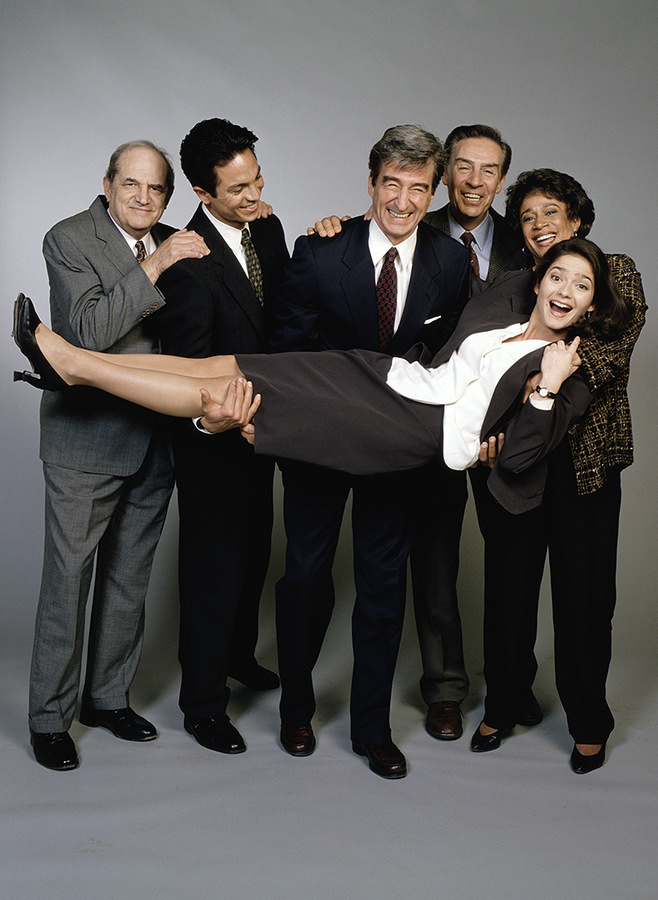
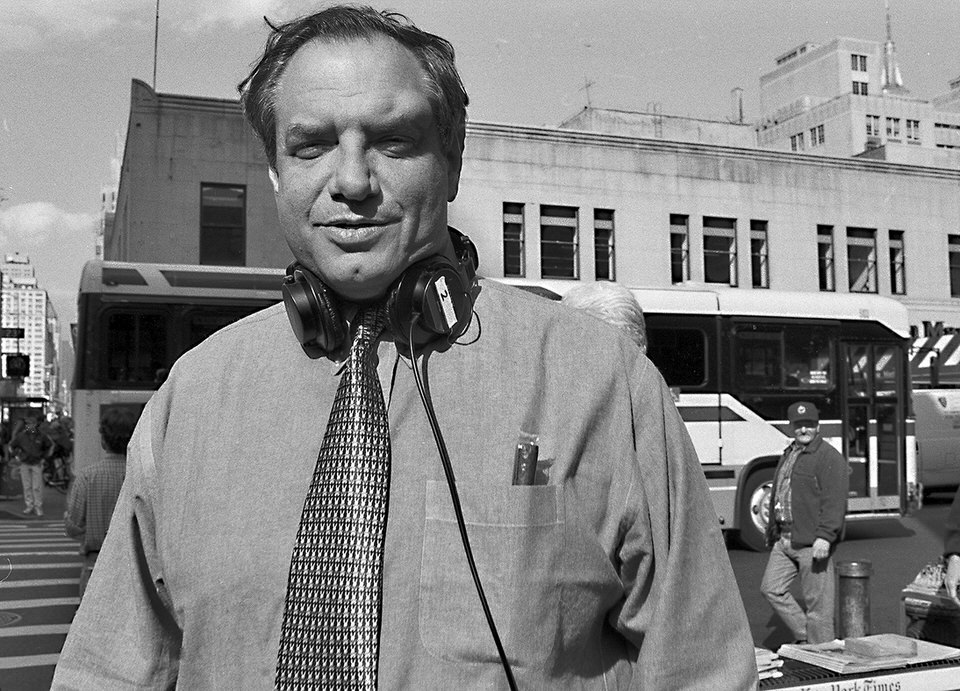
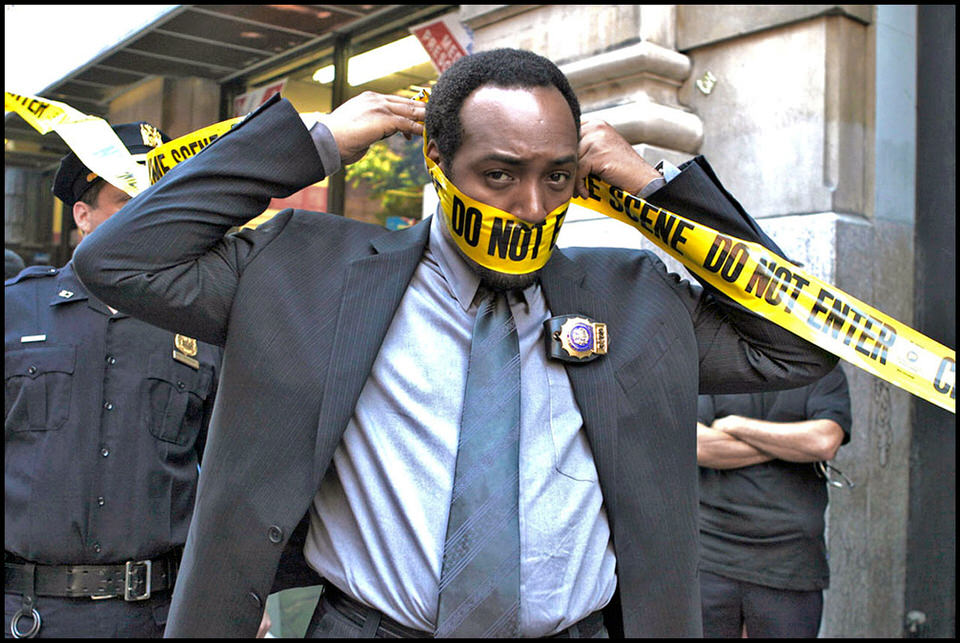

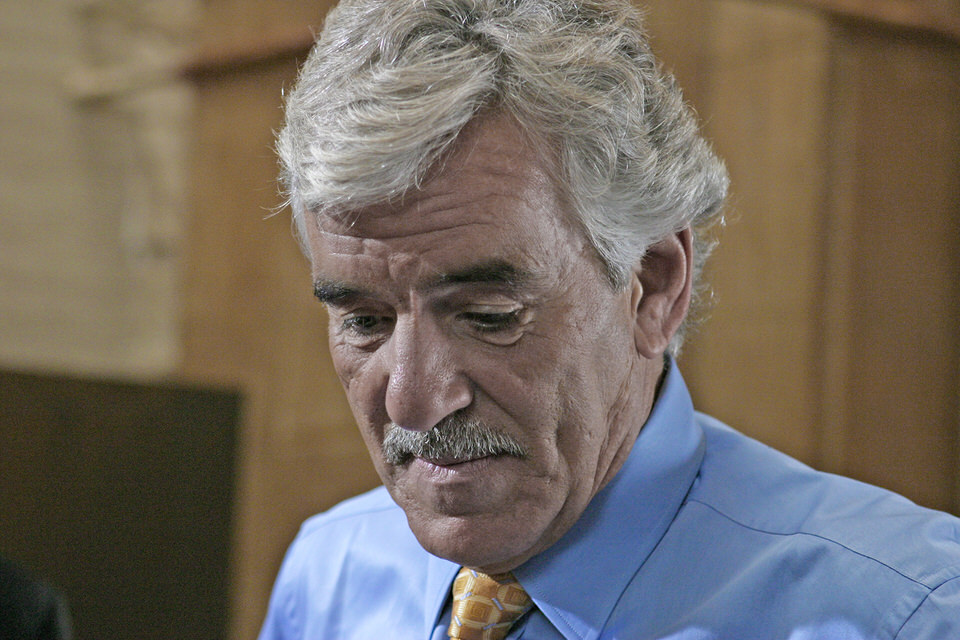
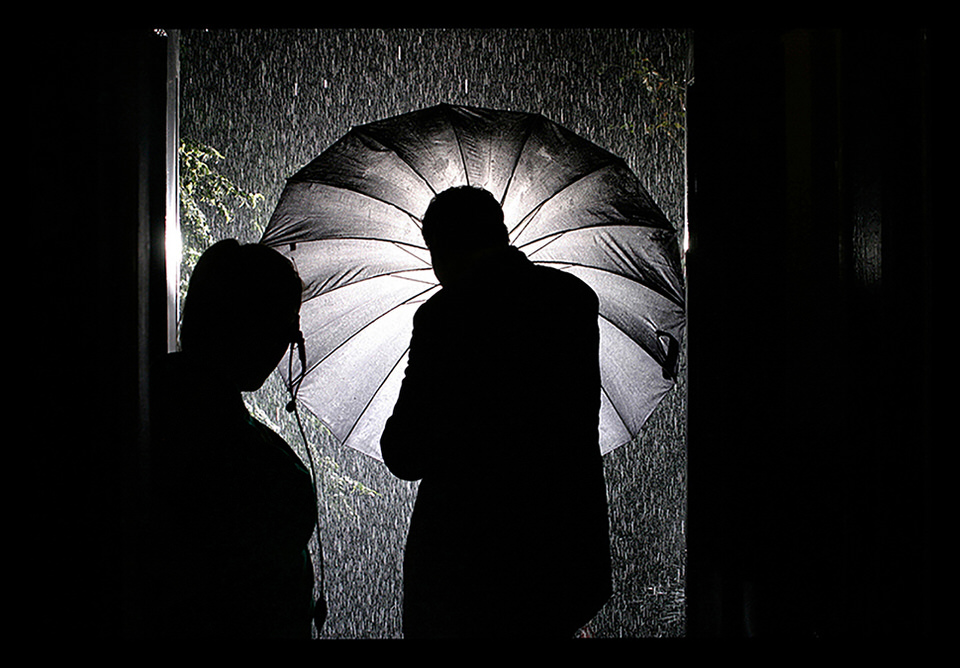


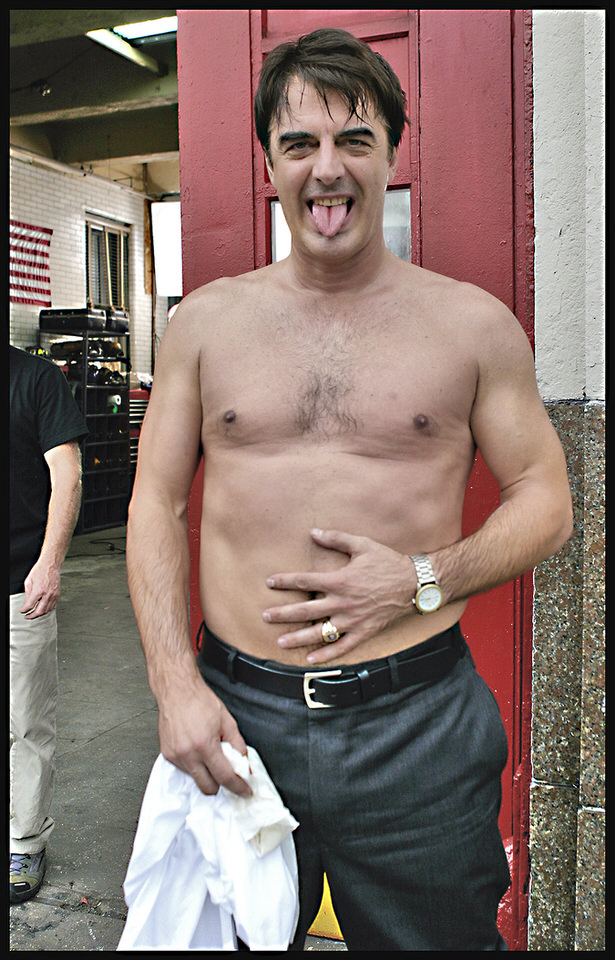
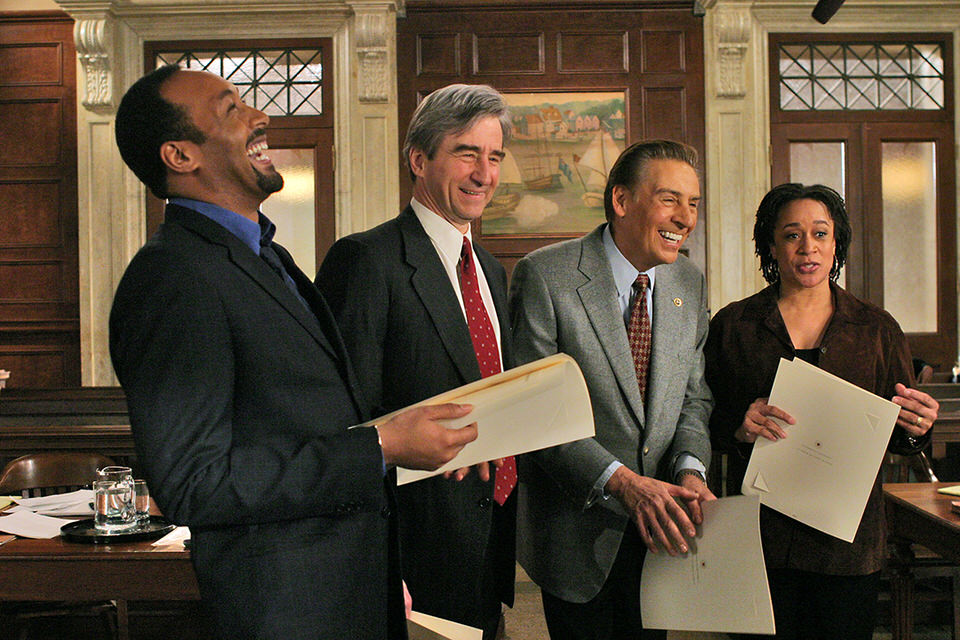
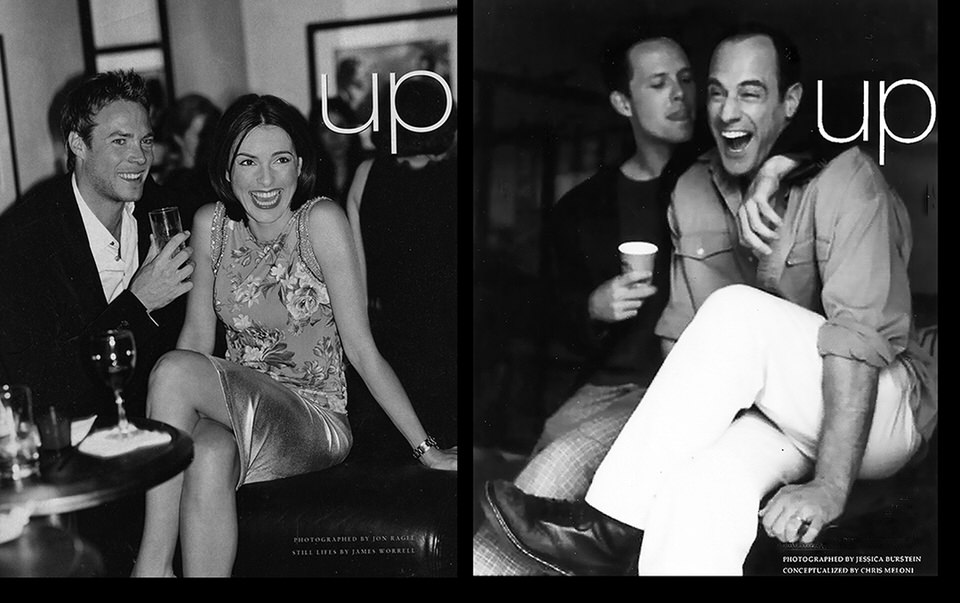
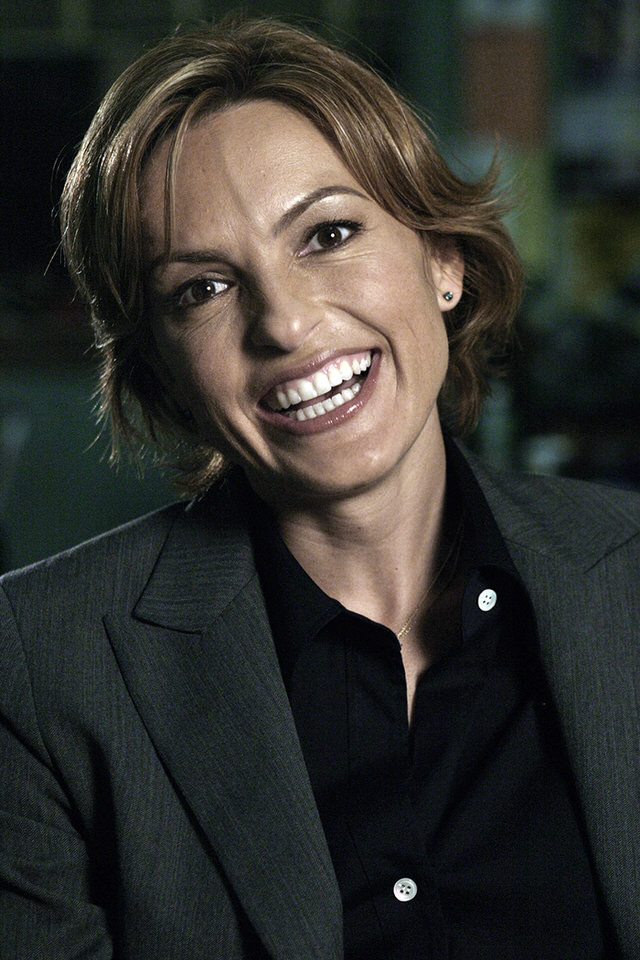

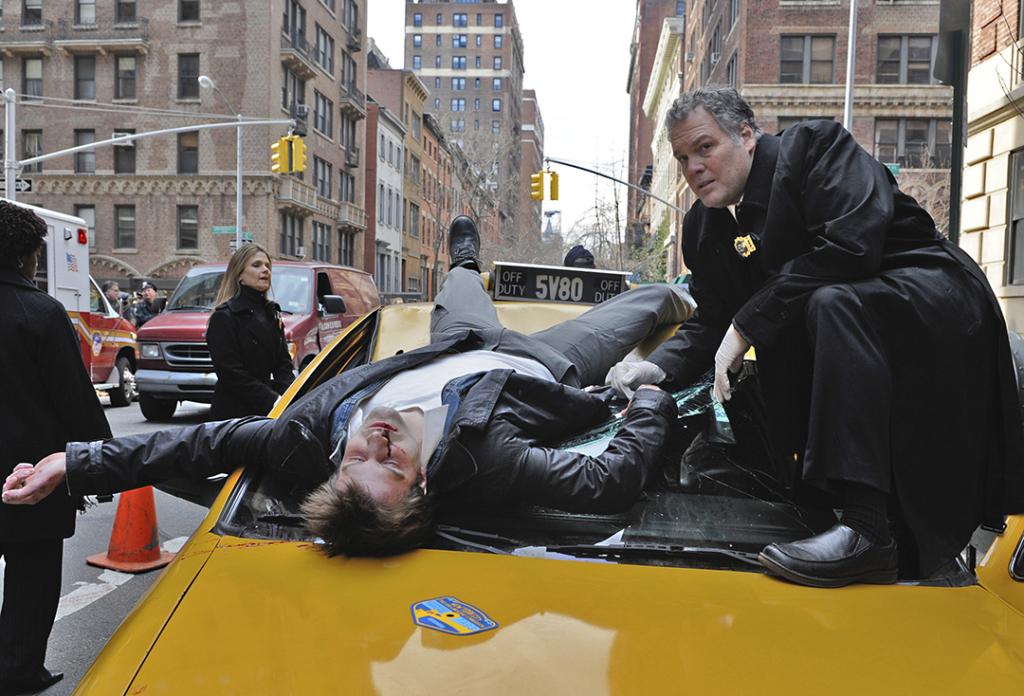
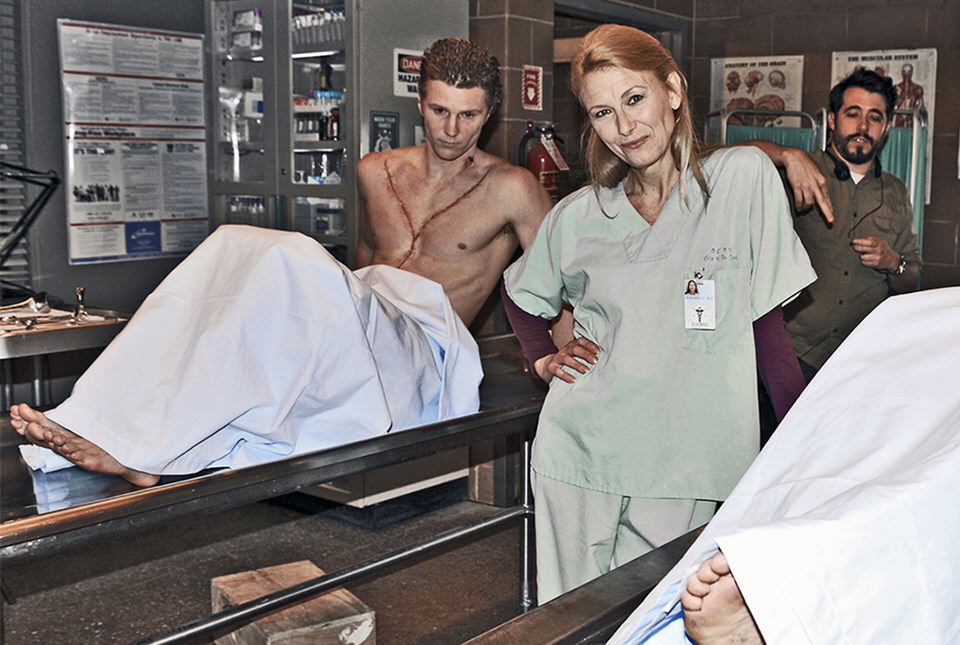
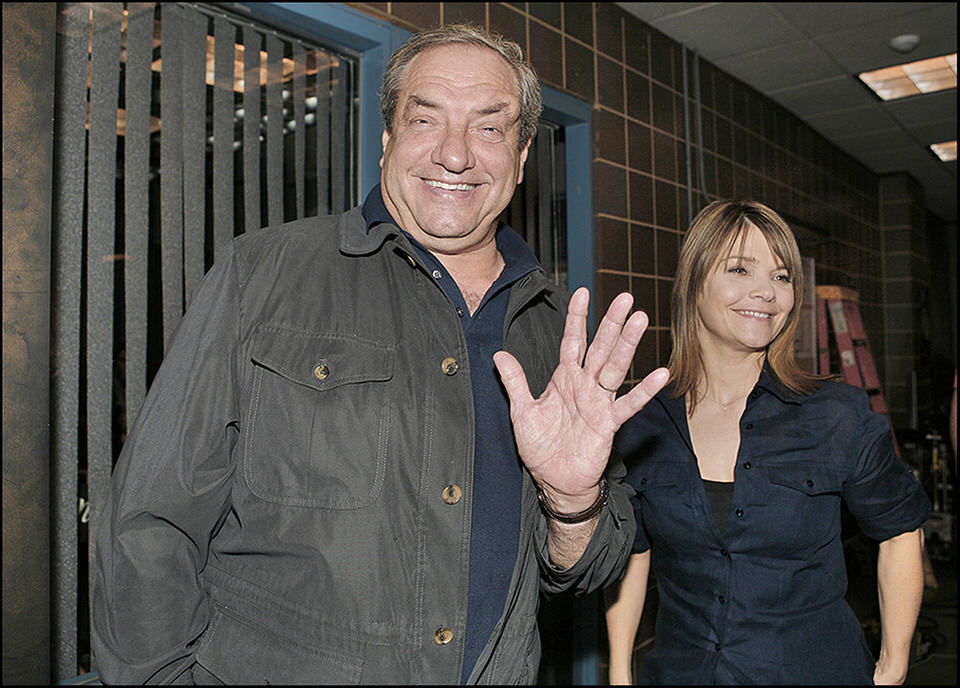

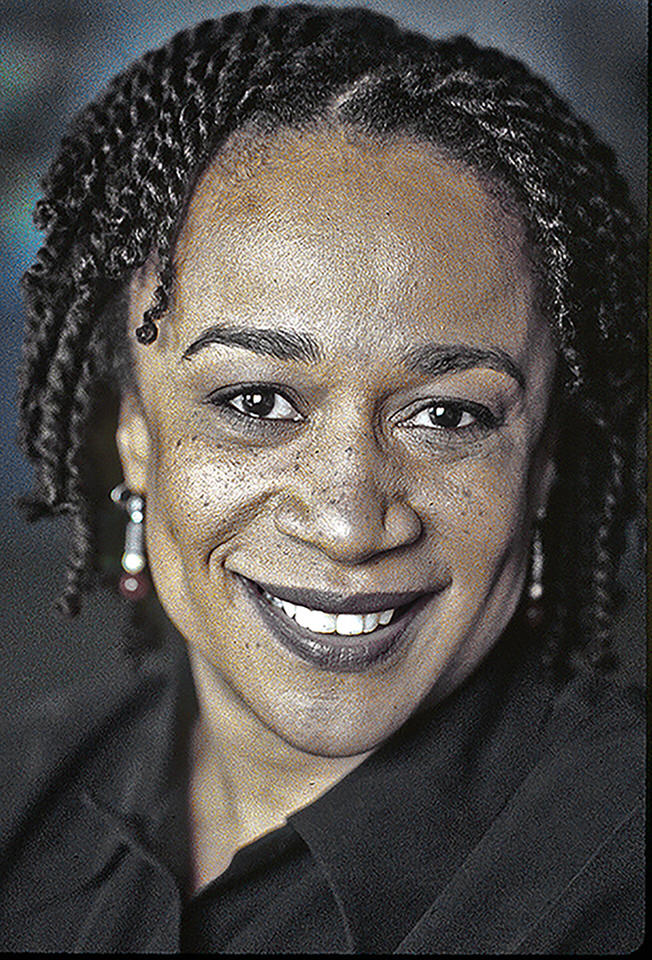

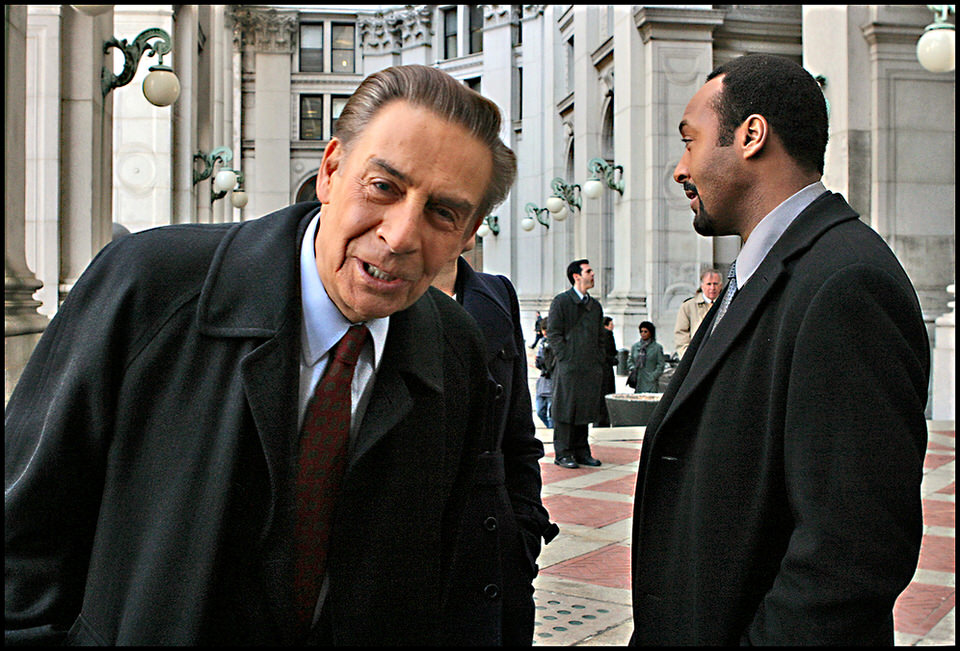
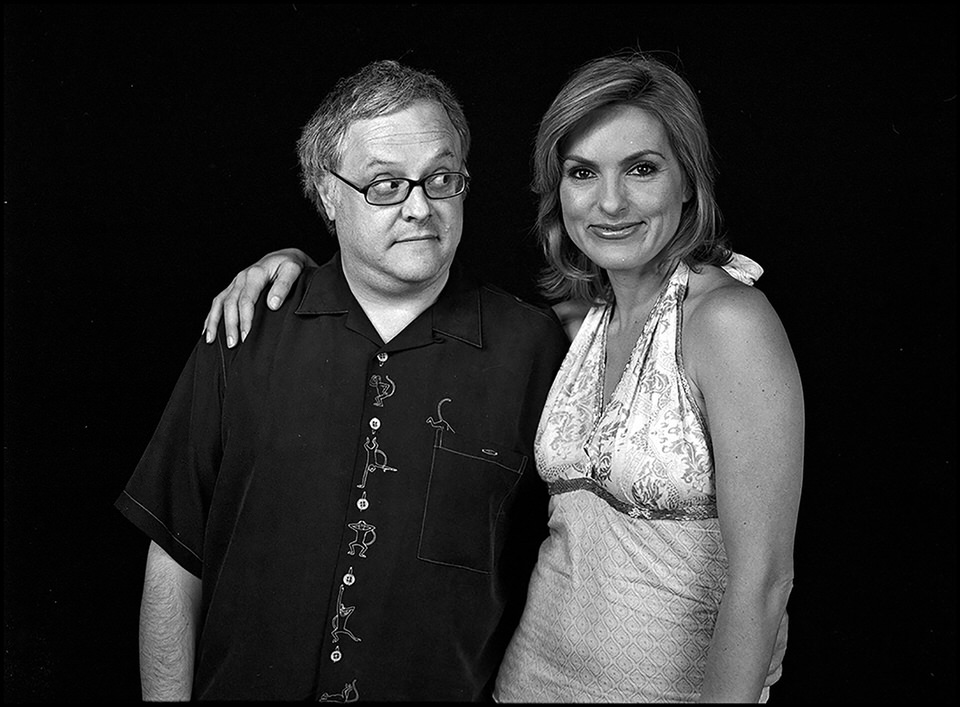
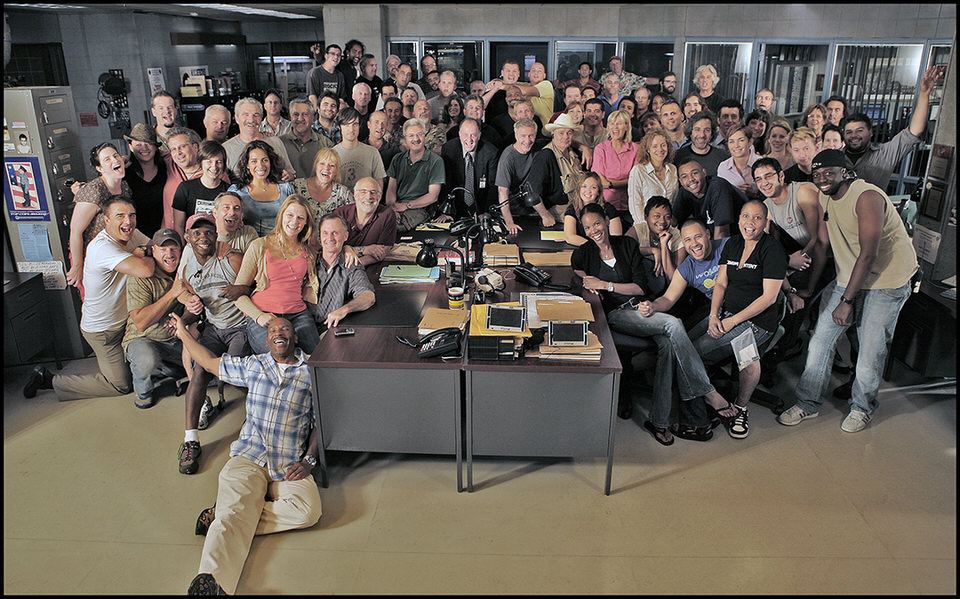
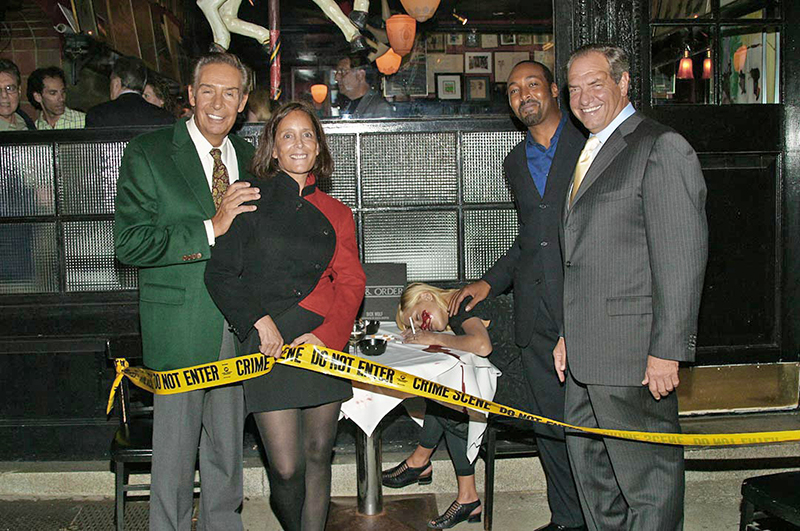
1 Comment
Great story! I loved all of the behind the scenes info…especially the “dirt” haha. Thank you for that. I still watch L&O when I’m up editing at 3am